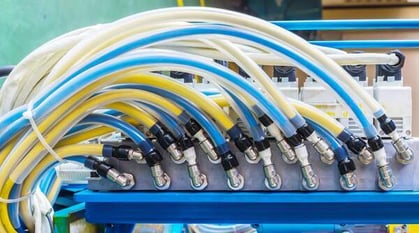Fast and Repeatable
 Push to Connect couplings allow for a fast and easy way to repeatedly connect and disconnect air or fluid lines. If a tube or hose in a fluid or air system needs to be disconnected and reconnected on a frequent basis the best solution is a Push to Connect fitting. It will improve productivity, ensure a properly sealed connection and eliminate downtime.
Push to Connect couplings allow for a fast and easy way to repeatedly connect and disconnect air or fluid lines. If a tube or hose in a fluid or air system needs to be disconnected and reconnected on a frequent basis the best solution is a Push to Connect fitting. It will improve productivity, ensure a properly sealed connection and eliminate downtime.
These fittings sometimes come as two components and have a poppet-style shutoff valve on each mating half. The shutoff, or check style valves, limit leakage during uncoupling and prevent air from entering the line when recoupling. They are also designed for minimum flow restriction, which minimizes pressure drop during equipment operation.
One of the most critical applications for Push to Connect fittings is air break lines in tractor trailers that must meet Department of Transportation (D.O.T.) guidelines, which we will discuss later.
Not to be Mistaken with Quick-Connect Fittings
Though the terms Push to Connect and Quick-Connect are sometimes mistakenly used to mean the same thing, there are true distinctive differences. Quick-Connect fittings are two-piece, usually with self-sealing valves on each half that contain the fluid or gas when disconnected. These quick couplers are available in sets of male and female, or one half (a quick-connect plug) and in a variety of sizes and materials. Stainless steel and brass are the most common because of their corrosion resistance.
For some quick-connect applications one end connection may be configured similarly to Push to Connect with easy assembly, simply pushing the tube into the fitting at one half by pulling the body backwards by hand which then retracts onto the tube with a PTFE seal. The other half will have a compression fitting connection, or male or female NPT. More frequently Quick-Connect fittings are used in high pressure applications, having a combination of compression and NPT male or female end connections.
If you'd like to learn more about PTC standards, applications & specs, click here or below to download our latest whitepaper that includes comprehensive information about PTC Fittings!
Sources:
- Hydraulics & Pneumatics
- Beswick Engineering
- Bendix Commercial Vehicles Systems, LLC
- Brennan, Inc.: Versa Fittings
- S. Department of Transportation: Federal Motor Carrier Safety Administration
- Yukon Department of Highways and Public Works
- The Spruce: All About Push-Fit Plumbing Fittings

